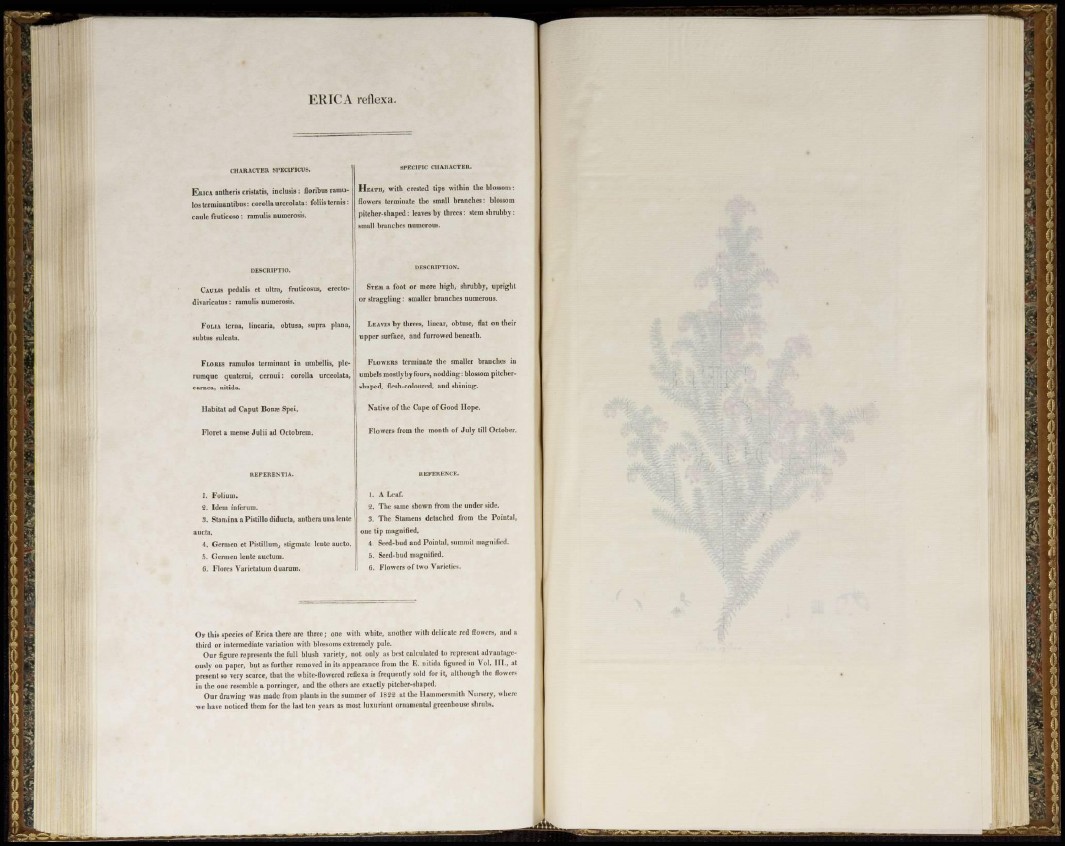
ERÏCÂ reflexa.
CHARACTER SPECIFICUS.
ERICA antheris cristatis, inclusis : floribus ramulos
terminantibus: corolla urceolata: foliis ternis :
caule fruticoso : ramnlis numerosis.
DESCRIPTIO.
CAÜLIS pedalis et ultra, fruticosus, erectodivaricatus
: ramnlis numerosis.
FOLIA lerna, linearia, obtusa, supra plana,
subtils sulcata.
FLORES ramulos terminant in umbellis, plerumque
quatcrni, cernui : corolla urceolata,
carnea, nitida.
Habitat ad Caput Bons Spei.
Floret a mense Julii ad Octobrem.
REFERESTIA.
1. Folium.
2. ídem inferum.
3. StaminaaPístilIodiducta, antberaunalcnte
ancla.
4. Germen et Pistillum, stigmale lente aucto.
5. Germen lente auctum.
C. Flores Varietatum duarum.
SPECIFIC CHARACTER.
HEATH, with crested tips within the blossom:
flowers terminate the small branches: blossom
pitcher-shaped : leaves by threes: stem shrubby :
small branches numerous.
DESCRIPTION-.
STEM a foot or more high, shrubby, upright
or straggling : smaller branches numerous.
LEAVES by threes, linear, obtuse, flat on their
upper surface, and furrowed beneath.
FLOWERS terminate the smaller branches in
umbels mostly by fours, nodding: blossom pitchershaped,
flesh-coloured, and shining.
Native of the Cape of Good Hope.
Flowers from the month of July till October.
REFERENCE.
1. A Leaf.
2. The same shown from the under side.
3. The Stamens detached from the Pointal,
one tip magnified.
& Seed-bud and Pointal, summit magnified.
5. Seed-bud magnified.
6. Flowers of two Varieties.
OF this species of Erica there are three; one with white, another with delicate red flowers, and a
third or intermediate variation with blossoms extremely pale.
Our figure represents the full blush variety, uot only as best calculated to represent advantageously
on paper, but as further removed in its appearance from the E. nitida figured in Vol. HI., at
present so very scarce, that the white-flowered reflexa is frequently sold for it, although the flowers
in the one resemble a porringer, and the others arc exactly pitcher-shaped.
Our drawing was made from plants in the summer of 1822 at the Hammersmith Nursery, where
we have noticed them for the last ten years as most luxuriant ornamental greenhouse shrubs.